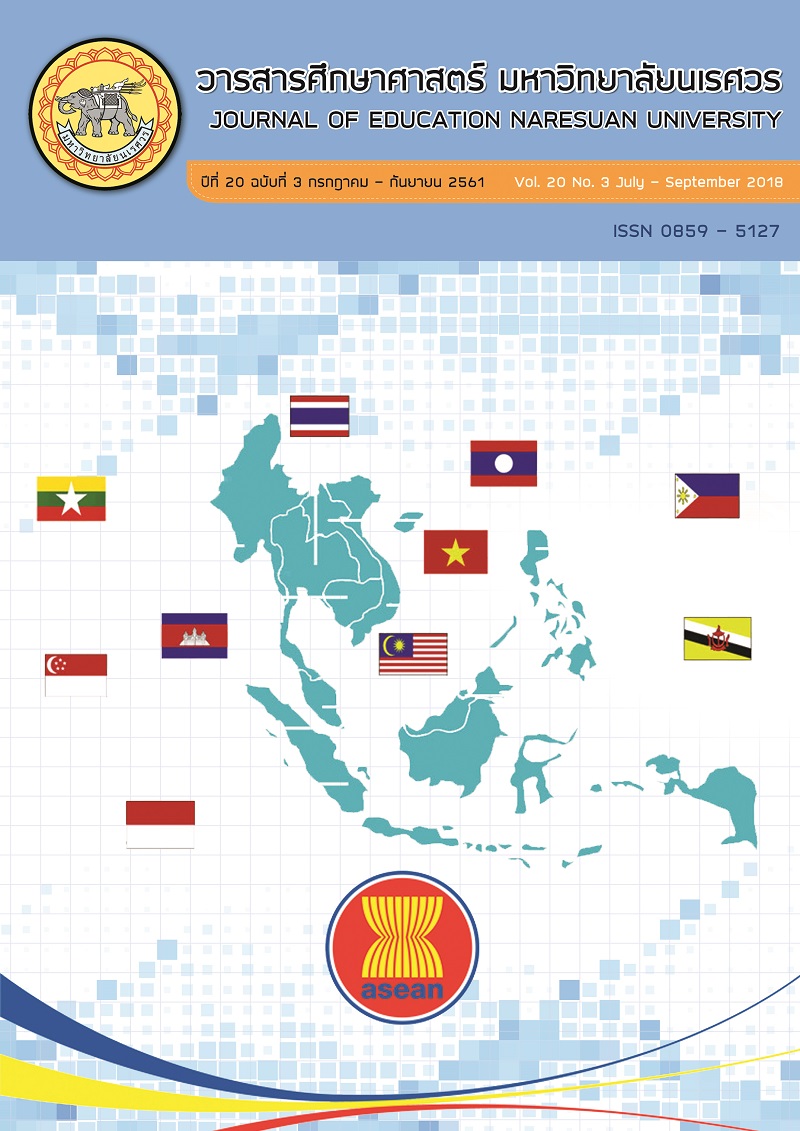ศึกษาผลการใช้ชุดกิจกรรมการเรียนรู้วิทยาศาสตร์ที่บูรณาการองค์ความรู้ตามแนวสะเต็มศึกษา สำหรับนักเรียนชั้นมัธยมศึกษาปีที่ 1; EFFECTS OF SCIENTIFIC LEARNING PACKAGE USING STEM EDUCATION IN GRADE 7 STUDENTS
Main Article Content
Abstract
การศึกษาวิจัยครั้งนี้มีวัตถุประสงค์ เพื่อเปรียบเทียบผลสัมฤทธิ์ทางการเรียน ความคิดสร้างสรรค์ทางวิทยาศาสตร์ และเจตคติทางวิทยาศาสตร์ก่อนเรียนและหลังเรียน ด้วยชุดกิจกรรมการเรียนรู้วิทยาศาสตร์ที่บูรณาการองค์ความรู้สะเต็มศึกษา สำหรับนักเรียนชั้นมัธยมศึกษาปีที่ 1 กลุ่มตัวอย่างที่ใช้ในการวิจัยครั้งนี้เป็นนักเรียนชั้นมัธยมศึกษาปีที่ 1 โรงเรียนชลกันยานุกูล จังหวัดชลบุรี จำนวน 42 คน ได้มาจากการสุ่มตัวอย่างแบบกลุ่ม (Cluster random sampling) โดยใช้ห้องเรียนเป็นหน่วยการสุ่ม โดยวิธีจับฉลากมา 1 ห้องเรียน จากจำนวน 12 ห้องเรียน เครื่องมือที่ใช้ในการวิจัย ได้แก่ ชุดกิจกรรมการเรียนรู้วิทยาศาสตร์ ที่บูรณาการองค์ความรู้ตามแนวสะเต็มศึกษา แบบทดสอบวัดผลสัมฤทธิ์ทางการเรียน แบบวัดความคิดสร้างสรรค์ทางวิทยาศาสตร์ และแบบวัดเจตคติทางวิทยาศาสตร์ โดยใช้วิธีการทดสอบค่าที (t-test dependent) ผลการวิจัย พบว่า
1. ผลสัมฤทธิ์ทางการเรียนรายวิชาวิทยาศาสตร์ เรื่อง พลังงานความร้อน ของนักเรียนชั้นมัธยมศึกษาปีที่ 1 หลังเรียนด้วยชุดกิจกรรมการเรียนรู้วิทยาศาสตร์สูงกว่าก่อนเรียน อย่างมีนัยสำคัญทางสถิติที่ระดับ .05
2. ความคิดสร้างสรรค์ทางวิทยาศาสตร์ของนักเรียนชั้นมัธยมศึกษาปีที่ 1 หลังเรียนด้วยชุดกิจกรรมการเรียนรู้วิทยาศาสตร์สูงกว่าก่อนเรียนอย่างมีนัยสำคัญทางสถิติที่ระดับ .05
3. เจตคติทางวิทยาศาสตร์ของนักเรียนชั้นมัธยมศึกษาปีที่ 1 หลังเรียนด้วยชุดกิจกรรมการเรียนรู้วิทยาศาสตร์สูงกว่าก่อนเรียนอย่างมีนัยสำคัญทางสถิติที่ระดับ .05
EFFECTS OF SCIENTIFIC LEARNING PACKAGE USING STEM EDUCATION IN GRADE 7 STUDENTS
The purposes of this study were to Compare achievement, creative thinking in science and scientific attitude of the students before and after learning by scientific learning packages. This study was carried out with 42 Grade 7 students who were studying in semester 2 of the academic year of 2015 at Chonkanyanukoon School. Cluster Random Sampling technique was used in order to identify sample. The instruments used in the study included Scientific learning packages, The Heat energy learning achievement test, The creative thinking in science test and Scientific attitude questionnaires. The data were analyzed by using the t-test. The research finding was as follows;
1. The students’ learning achievement in science of Grade 7 students after learning were higher than before studying by scientific learning package at the level .05
3. The students’ creative thinking in science of Grade 7 students after learning were higher than before studying by scientific learning package at the level .05
4. The students’ scientific attitude of Grade 7 students after learning were higher than before studying by scientific learning package at the level .05.
Article Details
The owner of the article does not copy or violate any of its copyright. If any copyright infringement occurs or prosecution, in any case, the Editorial Board is not involved in all the rights to the owner of the article to be performed.
References
Ceylan, S., & Ozdilek, Z. (2013). Improving a sample lesson plan for secondary science courses within the STEM Education (Master thesis). Turkey: Uludag University.
Chotana, K. (2011). The development of instruction package of environmental education on ecosystem Chayclong forest in Science for Prathomsuksa VI Students (Master thesis). Chonburi: Burapha University. (in Thai)
Chuabangkaew, M. (2013). The development of instruction model to promote analytical thinking integrated science process skills and scientific attitude (Doctoral dissertation). Chonburi: Burapha University. (in Thai)
Dhithjaroen, C. (2013). The development of creative thinking and achievement for grade 12 students using project learning base on constructionism programing of an apply robot subject (Master thesis). Khon Kaen: Khon Kaen University. (in Thai)
Institute for the Promotion of Teaching Science and Technology. (2014). The result of PISA 2012: reading literacy, mathematical literacy and scientific literacy. Bangkok: Aroon Printing. (in Thai)
Kaewpikul, J. (2011). A study on the achievement in chemistry and critical thinking of Mathayomsuksa VI students by using the 7E learning cycle model and conceptual change strategies (Master thesis). Bangkok: Srinakharinwirot University. (in Thai)
Kiatprawas, K. (1981). Educational innovation. Bangkok: Srinakharinwirot University. (in Thai)
Kijkuakul, S. (2015). STEM Education (Part II): How to integrate STEM Education in classroom teaching. Journal of Education Naresuan University, 17(3), 154 – 160. (in Thai)
Lou, S. J., et al. (2010). A study of project-based STEM Learning for senior high school students in Taiwan. Retrieved from http://www.peer.asee.org/a-study-of-project-based-stem-learning-in-taiwan.
Mataric, M. J., Koening, N., & Feil-Seifer, D. (2007). Materials for enabling hands-on robotics and STEM Education. Retrieved from http://www.aaa.org./pepers/Symposia/Spring/2007/SS-07-09/SS07-09-022.pdf
Maungsri, P. (2007). Comparisons of science learning achievement, creative thinking in science and scientific attitudes of Prathomsuksa 6 students who learning using 5e learning cycle and conventional learning method (Master thesis). Maha Sarakham: Mahasarakham University. (in Thai)
Meyrick, K. M. (2011). How to STEM Education improve student learning. Meridian K-12 School. Computer Technology Journal, 14(1). 1-16.
Panich, W. (2012). Framework for 21st century learning. Bangkok: Sodsri-Saridwongso Foundation. (in Thai)
Prathomwong, R. (2008). Comparisons of analytical thinking abilities, basic science process skills and learning achievement in the science learning strand entitled substances in the daily life of Prathomsueksa 6 students who learned using the 5e learning cycle and 7e learning cycle (Master thesis). Maha Sarakham: Mahasarakham University. (in Thai)
Saengpromsri, P., Nuangchalerm, P., & Chantiratikul, P. (2015). Comparisons of learning achievement, integrated science process skills, and attitude towards chemistry learning for Matthayomsueksa 5 students between STEM education and conventional methods. Journal of Education, Mahasarakham University, 9(special edition), 401-415. (in Thai)
Saiyod, L., & Saiyod, A. (1995). Measurement and evaluation learning techniques. Bangkok: Suweeriyasarn. (in Thai)
Shoosilp, P. (1998). Scientific attitude. Bangkok: Supervisory Unit. (in Thai)
The National Institute of Educational Testing Service (Public Organization). (2013). O-Net result report of Matayomsuksa 3 in 2013 academic year. Retrieved from http://www.onetresult.niets.or.th/AnnouncementWeb/PDF/SummaryONETM3_2558.pdf (in Thai)
Thomas, B. C. (2012). Critique the phenomena in Thai science classroom. Retrieved from http://www.qlf.or.th/Home/Contents/499 (in Thai)
Tongaht, C. (2012). Towards an ASEAN community: Educational management in the challenging contexts. Journal of Education Naresuan University, 14(3), 107-118. (in Thai)
Tongchai, A. (2013). What is technology and engineering in STEM Education? IPST Magazine, 41(185), 35-37. (in Thai)


